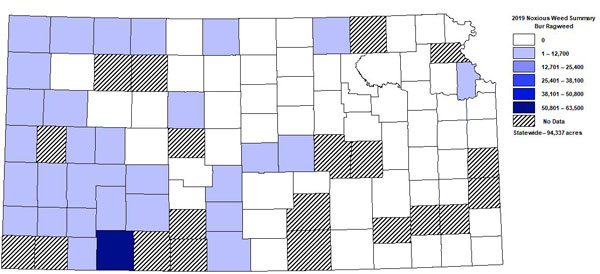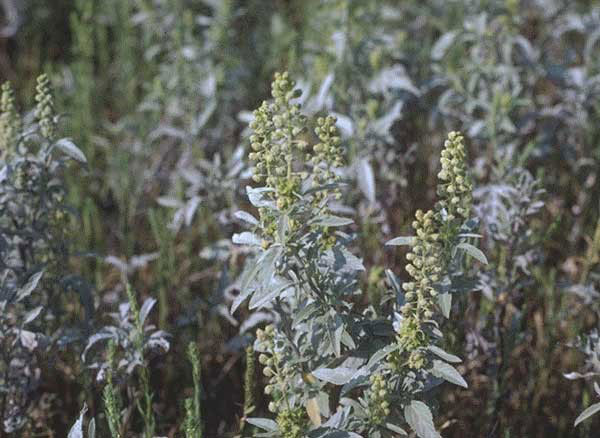For many perennial weeds, proper timing of herbicide applications is key. Early fall is a good time to spray for control of perennial broadleaf weeds such as bur ragweed, bindweed, and Canada thistle. As we move into October, this month’s World of Weeds article focuses on bur ragweed (Figure 1). Don’t miss an accompanying article in this eUpdate issue on controlling bindweed, another troublesome noxious weed found in Kansas.
Ecology of bur ragweed
Bur ragweed (also called woollyleaf bursage) is a perennial broadleaf weed, and is classified as a noxious weed in Kansas. It is a significant problem on over 94,000 acres throughout the state (Figure 1). It is adapted to low-lying areas where water collects in cultivated fields or in noncropland areas. Its ability to extract water with its deep perennial root system, which can reach a depth of 15 feet, allows bur ragweed to survive extended periods of drought or harsh weather. These characteristics make bur ragweed very difficult to control.
Bur ragweed is extremely competitive with crops, and can reduce grain yield by 100 percent in dry years. Even with irrigation, losses of 40 to 75 percent are common. Bur ragweed is more competitive with summer crops than with winter wheat because bur ragweed growth is minimal during much of the winter wheat life cycle. However, in dry years, bur ragweed will deplete soil moisture for fall-planted wheat and will thereby reduce grain yield.

Figure 1. Distribution of bur ragweed in Kansas, in terms of acreage. Map from the 2019 Noxious Weed Summary.
Identification
Shoots of bur ragweed will grow from root buds, emerging during April. It has silvery-grayish foliage covered with dense white hairs (Figure 2). Plants exhibit an erect growth habit and will reach 1 to 2 feet tall. Flower development begins in late July or early August. The fruits or “burs” can be up to 1/3 inch in length, are light-tan, and the hull is covered with sharp, hooked barbs.
Seed contributes to the spread of bur ragweed and likely is a source of new infestations. New plants also arise from the vegetative buds, which develop on the root stocks, thus contributing to the spread of bur ragweed. Tillage also can redistribute vegetative buds, aiding the spread of bur ragweed.

Figure 2. Bur ragweed. Photo by Curtis Thompson, K-State Research and Extension.
Management
Bur ragweed control is most effective when plants are treated in late summer or fall, prior to a killing frost, with Tordon tank-mixed with dicamba or 2,4-D ester. As with all herbicide applications, control will not be as effective if the bur ragweed plants are under stress at the time of treatment. Bur ragweed is a difficult weed to control, and a single application will usually not be sufficient. Fall application of the Group 4 herbicides mentioned above followed by glyphosate treatments in glyphosate-tolerant crops during the growing season can help manage bur ragweed long-term. However, spring crops may be injured severely from fall applications of Tordon. Wheat has the most tolerance and can be planted 45 days following a ½ pint of Tordon 22K application. Grain sorghum can be planted 8 months after application of 1 pt Tordon 22K
Table 1. Control of bur ragweed in western Kansas with mid-September treatments
|
Treatment |
Rate/Acre |
% Control 11 months after treatment |
|
Tordon + Banvel |
1 pt +1 pt |
82 |
|
Tordon + 2,4-D LV4 |
1 pt + 1 qt |
74 |
|
Roundup Power Max + Banvel |
44 oz + 1 pt |
16 |
|
Roundup Power Max + 2,4-D LV4 |
44 oz + 1 qt |
27 |
Source: Woollyleaf Bursage Biology and Control, MF 2239 http://www.ksre.ksu.edu/bookstore/pubs/MF2239.pdf
The use of trade names is for clarity to readers and does not imply endorsement of a particular product, nor does exclusion imply non-approval. Always consult the herbicide label for the most current use requirements.
Helpful resources
2020 Chemical Weed Control for Field Crops, Pastures, Rangeland, and Noncropland, K-State publication SRP-1148
Woollyleaf Bursage Biology and Control, K-State publication MF-22239.
Sarah Lancaster, Extension Weed Science Specialist
slancaster@ksu.edu
Randall Currie, Weed Scientist, KSU Southwest Research-Extension Center, Garden City
rscurrie@ksu.edu
Tags: World of Weeds bur ragweed noxious weed woollyleaf bursage